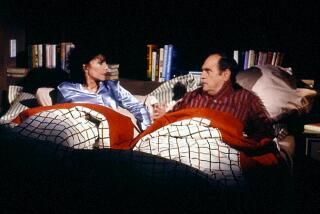Art critic Robert Hughes dies at 74
Robert Hughes, a giant of 20th-century art criticism who first became known in the U.S. through his reviews for Time magazine, has died at age 74.
The Australian writer was famous for writing big books on big subjects -- from the early history of Australia (“The Fatal Shore” of 1987) to the pioneers of modern art (“The Shock of the New” of 1981). Both books were bestsellers for his publisher Random House, which confirmed that Hughes died Monday in New York after a long illness. He also wrote a full history of Barcelona (1992) and a more personal history of Rome (2006), among several other titles.
But Hughes is probably best known for the strength of his convictions and the vigor or swagger (some would say bluster) of his take-no-prisoners prose. He mythologized favorite artists like Goya and Picasso and eviscerated his least favorite ones. (Artists who rose to fame in the overheated New York art scene of the 1980s, including Jean-Michel Basquiat and Julian Schnabel, took a particular beating.)
PHOTOS: Notable Deaths of 2012
In the process, Hughes gave intellectual heft to a common feeling outside the art world that contemporary art is empty at best, or a hoax at worst.
Born in Sydney to a family of lawyers and educated in Jesuit schools, Hughes began his career as an art critic in Australia. In 1965, he moved to London and wrote for the Observer, the Spectator and the Daily Telegraph.
In 1970, he moved to New York for a job as art critic for Time magazine.
One of his biggest accomplishments was creating and hosting a popular TV series on modern art called “The Shock of the New,” which aired on the BBC in 1980 and on PBS in 1981. (Episodes are now on youtube.) He also wrote a book by the same title.
In 1987, he published “The Fatal Shore,” his account of the British penal colonies and early settlement of Australia.
He nearly died in 1999 from a head-on car crash near Broome, Western Australia, which left him in a coma for several weeks. He was charged with two counts of dangerous driving for driving on the wrong side of the road. It would take years before he pleaded guilty in magistrates’ court to one charge of dangerous driving and paid a fine of $2,500 Australian dollars to settle the matter.
In recent years, a revised edition of “The Shock of the New” kept his name current, and the book is widely used today by colleges as a textbook introduction to modern art. But one of the biggest criticisms of Hughes is that he didn’t quite keep up with the times, failing to appreciate or understand more recent, post-war (or post-Warhol) developments.
As L.A. Times art critic Christopher Knight once wrote: “His criticism can be roughly split into two big chunks -- views on art before 1960 and art after -- and the principal difference between them is that art before 1960 is treated with deferential seriousness, even when the ultimate judgment is negative, while art after 1960 is regarded with glum suspicion, thus infecting any positive judgment with an Old Testament glow of moral triumph over worldly degradation.”
As Hughes himself once said, “Some think that so much of today’s art mirrors and thus criticizes decadence. Not so. It’s just decadent. Full Stop. It has no critical function, it is part of the problem.”
A complete obituary will follow on latimes.com
ALSO:
Gore Vidal, connoisseur of empires
‘Hairspray’ stage musical writer Mark O’Donnell dies at 58
Joan Stein dies at 59; Tony-winning theater and TV producer
More to Read
The biggest entertainment stories
Get our big stories about Hollywood, film, television, music, arts, culture and more right in your inbox as soon as they publish.
You may occasionally receive promotional content from the Los Angeles Times.










